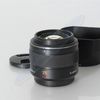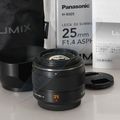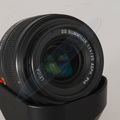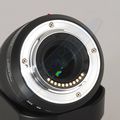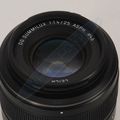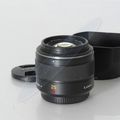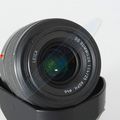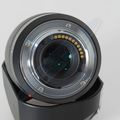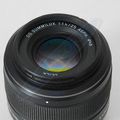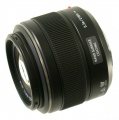LEICA DG SUMMILUX 1:1,4/25 ASPH.: Unterschied zwischen den Versionen
K (Fehler korrigiert) |
K (Kleinkram) |
||
| (4 dazwischenliegende Versionen desselben Benutzers werden nicht angezeigt) | |||
| Zeile 16: | Zeile 16: | ||
* [[Panasonic LUMIX G 20mm F1.7 ASPH.]] - kleiner ("[[Pancake]]"), [[Abbildungsfehler|optisch etwas besser]], soll aber Probleme mit hohen [[Kontrast]]en beim Filmen haben (fällt bei Standbildern aber nicht auf) | * [[Panasonic LUMIX G 20mm F1.7 ASPH.]] - kleiner ("[[Pancake]]"), [[Abbildungsfehler|optisch etwas besser]], soll aber Probleme mit hohen [[Kontrast]]en beim Filmen haben (fällt bei Standbildern aber nicht auf) | ||
* [[M.ZUIKO DIGITAL 25mm F1.8]] - [[Abbildungsfehler|gute optische Leistungen]], klein, leicht, Kunststofffassung | * [[M.ZUIKO DIGITAL 25mm F1.8]] - [[Abbildungsfehler|gute optische Leistungen]], klein, leicht, Kunststofffassung | ||
| − | * [[Sigma 30mm F2.8]] - [[Abbildungsfehler|gute optische Leistungen]], sehr gut verarbeitet (insbesondere die [[Sigma_30mm_F2.8#Sigma_30mm_F2.2C8_DN_.5BA.5D|"Art-Variante"]]), aber [[Lichtstärke|lichtschwächer]], wird (insbesondere gebraucht) sehr preiswert angeboten | + | * [[Sigma 30mm F2.8]] - [[Abbildungsfehler|gute optische Leistungen]], sehr gut verarbeitet (insbesondere die [[Sigma_30mm_F2.8#Sigma_30mm_F2.2C8_DN_.5BA.5D|"Art-Variante"]]), aber [[Lichtstärke|lichtschwächer]], wird (insbesondere gebraucht) sehr preiswert angeboten |
| + | |||
| + | == [[Firmware-Update]]s == | ||
| + | Wie auch bei vielen anderen [[Objektiv]]en liefert [[Panasonic]] auch hierzu umfangreiche [[Firmware-Update]]s: | ||
| + | {| | ||
| + | |bgcolor="#D1E8FF" align="center"|'''Version''' | ||
| + | |bgcolor="#D1E8FF" align="center"|'''Veröffentlichung am''' | ||
| + | |bgcolor="#D1E8FF" align="center"|'''Beschreibung''' | ||
| + | |- | ||
| + | |bgcolor="#D1E8FF" align="center"|'''1.0''' | ||
| + | |bgcolor="#D1E8FF" align="left"|- | ||
| + | |bgcolor="#D1E8FF" align="left"|Produkteinführung | ||
| + | |- | ||
| + | |bgcolor="#D1E8FF" align="center"|'''1.1''' | ||
| + | |bgcolor="#D1E8FF" align="left"|08.06.2021 | ||
| + | |bgcolor="#D1E8FF" align="left"|[Focus Ring Control] is available by this firmware update. (in case of the usage of Camera with this function)<br>Improved AF performance in FPS 24p mode(24.00p/23.98p)<br>Compatible products as of June 8th, 2021 : DC-GH5M2 | ||
| + | |- | ||
| + | |bgcolor="#D1E8FF" align="center"|'''1.2''' | ||
| + | |bgcolor="#D1E8FF" align="left"|01.03.2022 | ||
| + | |bgcolor="#D1E8FF" align="left"|It is possible to control AF operation by pressing the shutter button halfway, or by pressing the AF-ON button, when [200.00p] is set in high frame rate video mode.<br>Compatible products as of March 1st, 2022 : DC-GH6 | ||
| + | |} | ||
== Zitate == | == Zitate == | ||
| Zeile 27: | Zeile 47: | ||
Ein Zitat aus dem [http://www.traumflieger.de/reports/Objektiv-Tests/Micro-four-thirds/Panasonic-Leica-25mm-f1-4-im-Test::1259.html Test bei traumflieger.de]: | Ein Zitat aus dem [http://www.traumflieger.de/reports/Objektiv-Tests/Micro-four-thirds/Panasonic-Leica-25mm-f1-4-im-Test::1259.html Test bei traumflieger.de]: | ||
:''"Mit 200gr ist das Leica 25mm/1,4 kein absolutes Leichtgewicht mehr für Micro 4/3-Verhältnisse. Haptisch geht es voll in Ordnung. Zwar ist der Tubus in Kunststoff verschalt aber er wirkt dennoch recht hochwertig. Der elektronisch übersetzte Fokussierring ist angenehm leichtgängig und noch relativ breit ausgelegt. Insgesamt könnte das Objektiv jedoch noch einen Kick mehr an Wertigkeitseindruck auch angesichts des nicht ganz zu unterschätzenden Kaufpreises um 500 Euro vermitteln.<br>Letztlich überzeugt aber die gute Abbildungsleistung mit einem sehr hohen Gesamtschnitt von 1.998 Linien und einer noch guten Randauflösung trotz der hohen Lichtstärke. Das Bokeh gefällt uns zudem ausgezeichnet, so dass wir das Leica häufig und gerne einsetzen. Farbsäume, Verzeichnungen oder Vignettierungen spielen in der Praxis keine Bedeutung. Insoweit stimmt eigentlich alles am Leica - Traumflieger-Kauftipp und 4,5-Sterne von 5 möglichen!"'' | :''"Mit 200gr ist das Leica 25mm/1,4 kein absolutes Leichtgewicht mehr für Micro 4/3-Verhältnisse. Haptisch geht es voll in Ordnung. Zwar ist der Tubus in Kunststoff verschalt aber er wirkt dennoch recht hochwertig. Der elektronisch übersetzte Fokussierring ist angenehm leichtgängig und noch relativ breit ausgelegt. Insgesamt könnte das Objektiv jedoch noch einen Kick mehr an Wertigkeitseindruck auch angesichts des nicht ganz zu unterschätzenden Kaufpreises um 500 Euro vermitteln.<br>Letztlich überzeugt aber die gute Abbildungsleistung mit einem sehr hohen Gesamtschnitt von 1.998 Linien und einer noch guten Randauflösung trotz der hohen Lichtstärke. Das Bokeh gefällt uns zudem ausgezeichnet, so dass wir das Leica häufig und gerne einsetzen. Farbsäume, Verzeichnungen oder Vignettierungen spielen in der Praxis keine Bedeutung. Insoweit stimmt eigentlich alles am Leica - Traumflieger-Kauftipp und 4,5-Sterne von 5 möglichen!"'' | ||
| + | |||
| + | Ein Zitat aus [https://www.digitalkamera.de/Zubeh%C3%B6r-Test/Testbericht_Panasonic_Leica_DG_Summilux_25_mm_1_4_II_Asph/12463.aspx "Testbericht: Panasonic Leica DG Summilux 25 mm 1.4 II Asph." in digitalkamera.de]: | ||
| + | :''"Mit knapp unter 600 Euro ist das Panasonic Leica DG Summilux 25 mm 1.4 II Asph. kein Schnäppchen. Dafür bekommt man jedoch ein ordentlich verarbeitetes, robustes und vor allem sehr leichtes und kompaktes Objektiv."<br>....<br>"Der Autofokus ist äußert flott und flüsterleise, auch die manuelle Fokussierung gelingt sehr feinfühlig. Im Gegenlicht zeigt sich das Normalobjektiv souverän, das Bokeh kann sich ebenfalls sehen lassen. Zudem sind die optischen Fehler gering, was leider auch auf die Auflösung zutrifft."'' | ||
Ein Zitat aus dem [http://robinwong.blogspot.it/2014/02/olympus-mzuiko-25mm-f18-lens-review.html Vergleichstest mit dem M.ZUIKO DIGITAL 25mm F1.8 bei robinwong.blogspot.it]: | Ein Zitat aus dem [http://robinwong.blogspot.it/2014/02/olympus-mzuiko-25mm-f18-lens-review.html Vergleichstest mit dem M.ZUIKO DIGITAL 25mm F1.8 bei robinwong.blogspot.it]: | ||
| Zeile 54: | Zeile 77: | ||
== Lieferumfang == | == Lieferumfang == | ||
* [[Leica|LEICA]] DG SUMMILUX 1:1,4/25 ASPH. / [[Leica|LEICA]] DG SUMMILUX 1:1,4/25 II ASPH. | * [[Leica|LEICA]] DG SUMMILUX 1:1,4/25 ASPH. / [[Leica|LEICA]] DG SUMMILUX 1:1,4/25 II ASPH. | ||
| − | * [[MFT|Micro Four Thirds]] [[Objektiv]]deckel | + | * [[MFT|Micro Four Thirds]] [[Objektiv]]deckel |
| + | * [[Gegenlichtblende]] H-X025 | ||
* hintere [[Objektiv]]kappe für Micro Four Thirds Objektive | * hintere [[Objektiv]]kappe für Micro Four Thirds Objektive | ||
* Garantieunterlagen und Bedienungsanleitung | * Garantieunterlagen und Bedienungsanleitung | ||
| + | Anmerkung: Lt. diversen Nutzermeinungen kann (z.B. als Ersatz) auch die [[Gegenlichtblende]] des [[LEICA DG MACRO-ELMARIT 1:2.8/45 ASPH.]] verwendet werden. | ||
== Varianten == | == Varianten == | ||
| Zeile 86: | Zeile 111: | ||
* Nano Surface Coating | * Nano Surface Coating | ||
* kompatibel zum Highspeed-Präzisions-Kontrast-AF-System der aktuellen LUMIX G Kameras mit einem Datenaustausch bis maximal 240 B/s | * kompatibel zum Highspeed-Präzisions-Kontrast-AF-System der aktuellen LUMIX G Kameras mit einem Datenaustausch bis maximal 240 B/s | ||
| + | |||
| + | Hierzu ein Zitat aus [https://www.digitalkamera.de/Zubeh%C3%B6r-Test/Testbericht_Panasonic_Leica_DG_Summilux_25_mm_1_4_II_Asph/12463.aspx "Testbericht: Panasonic Leica DG Summilux 25 mm 1.4 II Asph." in digitalkamera.de]: | ||
| + | :''"Zwar blieb der optische Aufbau identisch, die kompakte Festbrennweite erhielt aber eine schnellere Kommunikation mit der Kamera für einen verbesserten Autofokus sowie einen Spritzwasser- und Staubschutz."'' | ||
Panasonic-Code: H-XA025 | Panasonic-Code: H-XA025 | ||
| Zeile 194: | Zeile 222: | ||
* [http://www.peterlueck.com/fotografie/nokton-250-95-vs-panasonic-lumix-dg-251-4/ "Nokton 25/0.95 vs. Panasonic Lumix DG 25/1.4" von Peter Lück] | * [http://www.peterlueck.com/fotografie/nokton-250-95-vs-panasonic-lumix-dg-251-4/ "Nokton 25/0.95 vs. Panasonic Lumix DG 25/1.4" von Peter Lück] | ||
* [http://benjamin-jehne.blogspot.de/p/review-panasonic-leica-dg-summilux-25mm.html Review bei benjamin-jehne.blogspot.de] | * [http://benjamin-jehne.blogspot.de/p/review-panasonic-leica-dg-summilux-25mm.html Review bei benjamin-jehne.blogspot.de] | ||
| + | * [https://www.digitalkamera.de/Zubeh%C3%B6r-Test/Testbericht_Panasonic_Leica_DG_Summilux_25_mm_1_4_II_Asph/12463.aspx "Testbericht: Panasonic Leica DG Summilux 25 mm 1.4 II Asph." in digitalkamera.de] | ||
* [https://www.digitalkamera.de/Meldung/Labortest_des_Panasonic_Leica_DG_Summilux_25_mm_1_4_II_an_der_GH5_II/12452.aspx Labortest des "Panasonic Lumix 25mm 1.4 Mk II" bei digitalkamera.de] (kostenpflichtig) | * [https://www.digitalkamera.de/Meldung/Labortest_des_Panasonic_Leica_DG_Summilux_25_mm_1_4_II_an_der_GH5_II/12452.aspx Labortest des "Panasonic Lumix 25mm 1.4 Mk II" bei digitalkamera.de] (kostenpflichtig) | ||
* [http://robinwong.blogspot.it/2014/02/olympus-mzuiko-25mm-f18-lens-review.html Vergleichstest mit dem M.ZUIKO DIGITAL 25mm F1.8 bei robinwong.blogspot.it] (englisch) | * [http://robinwong.blogspot.it/2014/02/olympus-mzuiko-25mm-f18-lens-review.html Vergleichstest mit dem M.ZUIKO DIGITAL 25mm F1.8 bei robinwong.blogspot.it] (englisch) | ||
Aktuelle Version vom 18. Dezember 2024, 12:36 Uhr
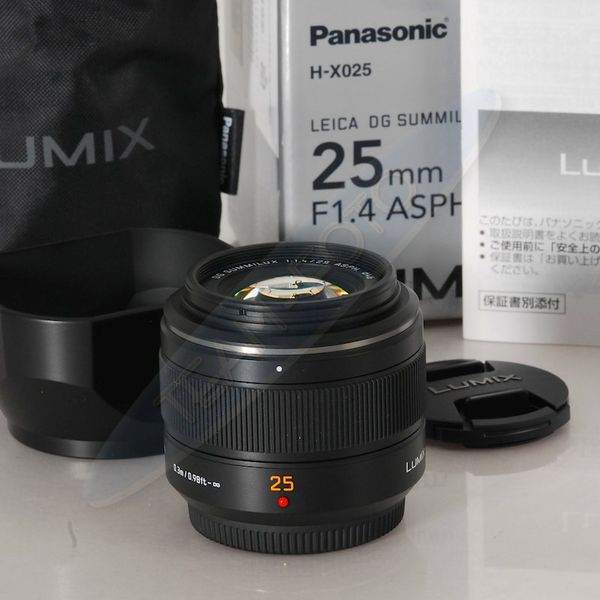
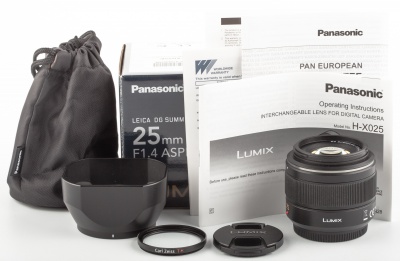
Beschreibung
Ein Normalobjektiv von Panasonic für die Pen-Kameras (MFT), das Objektiv wurde 2012 vorgestellt.
Vergleichbar einem 50 mm-Objektiv im Kleinbildformat ist es ein Vertreter der lichtstarken Normal-Objektive.
Es halten sich hartnäckige Gerüchte, dass das Objektiv nicht von Leica sondern - wie schon das LEICA DG MACRO-ELMARIT 1:2.8/45 ASPH. und das LEICA DG VARIO-ELMARIT 1:2.8-4.0/8-18 ASPH. - von Konica gerechnet wurde. Da das LEICA DG SUMMILUX 1:1,4/25 ASPH. aber eine sehr gute optische Leistung bietet und hervorragend verarbeitet ist, ist dies lt. der überwiegenden Nutzermeinungen unbeachtlich - es sei denn, dass man dem Markenzeichen mit dem "roten Punkt" verbunden ist.
Betrachtet man die direkten Konkurrenten aus dem mFT-Festbrennweiten-Programm von Olympus und Sigma, so ist es das kleinste Objektiv - aber:
- M.ZUIKO DIGITAL ED 25mm 1:1.2 PRO - etwas lichtstärker (1/2 Blende), optisch gleichwertig, größer und schwerer, sehr teuer
- Sigma 30mm F1.4 DC DN Contemporary - optisch gleichwertig, sehr groß und schwer (ursprünglich für den APS-C-Bildkreis berechnet), für den "Straßenpreis" eine sehr gute Empfehlung, wenn man mit der Größe leben kann
Sollte die Lichtstärke nicht gebraucht werden, so sind folgende Objektive - deren Lichtstärke meist nur um eine 1/2 Blende schwächer ist - in Betracht gezogen werden:
- Panasonic LUMIX G 25mm F1.7 ASPH. - in allen Belangen mit dem M.ZUIKO DIGITAL 25mm F1.8 vergleichbar - "Gefühlsentscheidung"
- Panasonic LUMIX G 20mm F1.7 ASPH. - kleiner ("Pancake"), optisch etwas besser, soll aber Probleme mit hohen Kontrasten beim Filmen haben (fällt bei Standbildern aber nicht auf)
- M.ZUIKO DIGITAL 25mm F1.8 - gute optische Leistungen, klein, leicht, Kunststofffassung
- Sigma 30mm F2.8 - gute optische Leistungen, sehr gut verarbeitet (insbesondere die "Art-Variante"), aber lichtschwächer, wird (insbesondere gebraucht) sehr preiswert angeboten
Firmware-Updates
Wie auch bei vielen anderen Objektiven liefert Panasonic auch hierzu umfangreiche Firmware-Updates:
| Version | Veröffentlichung am | Beschreibung |
| 1.0 | - | Produkteinführung |
| 1.1 | 08.06.2021 | [Focus Ring Control] is available by this firmware update. (in case of the usage of Camera with this function) Improved AF performance in FPS 24p mode(24.00p/23.98p) Compatible products as of June 8th, 2021 : DC-GH5M2 |
| 1.2 | 01.03.2022 | It is possible to control AF operation by pressing the shutter button halfway, or by pressing the AF-ON button, when [200.00p] is set in high frame rate video mode. Compatible products as of March 1st, 2022 : DC-GH6 |
Zitate
Ein Zitat aus dem Review bei benjamin-jehne.blogspot.de:
- "Die Abbildungsleistung:
Gleich vorweg, dies ist mein derzeit schärfstes Objektiv im mFT-System. Es ist eine Linse mit erstaunlich guten Abbildungsleistungen und dies über den gesamten Blendenbereich.
Bei Blende F4.5 liegt die höchste Schärfe beim Panasonic Leica DG Summilux 25mm F1.4 an. Die Schärfe ist nur in den äußersten Ecken nicht ganz perfekt, ansonsten zeigt sich das Bild sehr homogen. Die Farben und Kontraste sind für meinen Geschmack hervorragend.
Leider ist das Objektiv nicht ganz frei von Chromatischen Aberrationen (CAs)."
Ein Zitat aus dem Test in photozone.de:
- " The Panasonic Leica DG Summilux 25mm f/1.4 ASPH is a very desirable lens. The important center resolution is already on a very good level straight from wide open aperture. The border quality is decent but the corners are softer here. The quality is very high across most of the image field when stopping down to f/2.8. However, the extreme corners remain only "good" here. Lateral CAs as well as distortions are all well controlled and not relevant in field conditions. In addition, the quality of the bokeh is very good.
Typical for a fast lens, the vignetting is somewhat disappointing at wide open aperture and this applies also to the corrected RAW files. The build quality is very good and photographers as well as movie enthusiasts will appreciate the fast and silent AF operation. The Panasonic Leica DG Summilux 25mm f/1.4 ASPH is undoubtedly an great option in the micro-four-thirds system but unfortunately not cheap."
Ein Zitat aus dem Test bei traumflieger.de:
- "Mit 200gr ist das Leica 25mm/1,4 kein absolutes Leichtgewicht mehr für Micro 4/3-Verhältnisse. Haptisch geht es voll in Ordnung. Zwar ist der Tubus in Kunststoff verschalt aber er wirkt dennoch recht hochwertig. Der elektronisch übersetzte Fokussierring ist angenehm leichtgängig und noch relativ breit ausgelegt. Insgesamt könnte das Objektiv jedoch noch einen Kick mehr an Wertigkeitseindruck auch angesichts des nicht ganz zu unterschätzenden Kaufpreises um 500 Euro vermitteln.
Letztlich überzeugt aber die gute Abbildungsleistung mit einem sehr hohen Gesamtschnitt von 1.998 Linien und einer noch guten Randauflösung trotz der hohen Lichtstärke. Das Bokeh gefällt uns zudem ausgezeichnet, so dass wir das Leica häufig und gerne einsetzen. Farbsäume, Verzeichnungen oder Vignettierungen spielen in der Praxis keine Bedeutung. Insoweit stimmt eigentlich alles am Leica - Traumflieger-Kauftipp und 4,5-Sterne von 5 möglichen!"
Ein Zitat aus "Testbericht: Panasonic Leica DG Summilux 25 mm 1.4 II Asph." in digitalkamera.de:
- "Mit knapp unter 600 Euro ist das Panasonic Leica DG Summilux 25 mm 1.4 II Asph. kein Schnäppchen. Dafür bekommt man jedoch ein ordentlich verarbeitetes, robustes und vor allem sehr leichtes und kompaktes Objektiv."
....
"Der Autofokus ist äußert flott und flüsterleise, auch die manuelle Fokussierung gelingt sehr feinfühlig. Im Gegenlicht zeigt sich das Normalobjektiv souverän, das Bokeh kann sich ebenfalls sehen lassen. Zudem sind die optischen Fehler gering, was leider auch auf die Auflösung zutrifft."
Ein Zitat aus dem Vergleichstest mit dem M.ZUIKO DIGITAL 25mm F1.8 bei robinwong.blogspot.it:
- " What are the differences between these two lenses, really? If you look at the optical design, both lenses have 7 groups and 9 elements. Knowing Olympus Zuiko Quality from the previous lenses line-up, I would expect very little distortion, very good control of CA, excellent corner to corner sharpness and most important of all, excellent sharpness and fine detail rendering. The main differences between these two lenses are: 1) The Panasonic 25mm costs almost twice as much as the Olympus 25mm (true for local Malaysian pricing) 2) The Panasonic 25mm F1.4 is F0.4 brighter/faster than the Olympus 25mm F1.8 and 3) The Panasonic 25mm F1.4 lens is larger and heavier than the Olympus 25mm F1.8 lens. Since we all know about number 1) and number 3) already, lets take a closer look at point number 2) F0.4 brightness difference. How big is the F0.4 difference between two lenses?
F0.4 tranlastes to 2/3 of an EV stop, and is not even a full stop advantage. Faster aperture means the lens can have two advantages: 1) Produce shallower depth of field, meaning able to create more blur background to isolate the main subject better, and 2) ability to use faster shutter speed in low light condition. The question that drives me to do this comparison, is to find out how much more blur can the F0.4 difference create, and to compare the shallow depth of field between F1.8 and F1.4 and to see the gap of the two lenses. Also, how much advantage of shutter speed can the F1.4 deliver. Is F1.4 really that much better than F1.8? Does it make that much of a difference? Remember, we are NOT talking about Canon or Nikon 50mm F1.4 vs 50mm F1.8 lenses here, we are talking about Panasonic vs Olympus, and I think by far this is the most interesting experiment I have done for any of my reviews."
Ein Zitat aus dem Review bei lenstip.com:
- "Looking at the Micro 4/3 system as a whole it is clear that the Leica DG SUMMILUX 25 mm f/1.4 ASPH. fits here perfectly well, enlarging nicely the available choice of lenses. If you don’t need a very fast standard you can buy the Panasonic 1.7/20 pancake. If you need something really fast and don’t mind manual focus, you can get interested in the Voigtlander 0.95/25. The Leica can be placed right in the middle. Its price is similar to that of the Voigtlander and worse fastness is balanced out by the autofocus and smaller dimensions which fit the system better. All three lenses, mentioned here, have very good optical properties. Which one to choose Is a matter of taste, individual preferences and the capacity of your wallet."
Ein Zitat aus "Comparing two Panasonic standard primes – Lumix 25mm f/1.7 vs. Leica 25mm f/1.4" in irrorlessons.com:
- "The Lumix 25mm f/1.7 and Leica 25mm f/1.4 are both valid choices for the Micro Four Thirds photographer who is in the process of building up a collection of primes. As is often the case with these comparisons, whether you choose one or the other really depends on your needs and budget.
In terms of pure optical quality, the prize goes to the Leica but this is logical considering the price difference between the two. Not only is it marginally sharper at all apertures but it also has a slightly more pleasing bokeh and the added bonus of a f/1.4 aperture that performs as well as the Lumix at f/1.7.
However, the Lumix has its own set of surprises up its sleeve. Its focus mechanism is quieter and faster and it has the added benefit of a closer minimum focusing distance. This means that, even though the Leica has a nicer bokeh overall, you can achieve a blurrier background with the Lumix if you focus as close as possible to your subject.
ersonally speaking, if I were to start my Micro Four Thirds collection all over again, I would probably chose the Lumix version instead of the Leica. (In fact, the primary reason we picked up the Leica is because we found it at a very good price second hand.) Besides the fact that it is extremely affordable, its performance is enough for my personal photography needs and I love how it hardly adds any weight or bulk to our cameras."
Ein Zitat aus dem Review bei kurtmunger.com:
- "f you're looking for a 50mm equivalent prime lens for your micro 4/3 camera, look no further than the Panasonic 25mm F/1/4. This lens is somewhat pricey, but the optical quality easily makes it worth it!"
"Build quality is good, not great, however it does have a metal mount and feels solid in the hand. The wide focus ring makes manual focusing easy with the camera to your eye."
"Other items worthy of mention are the lack of color fringing along the sides of the image, low to almost no distortion with correction turned on, and moderate light fall-off wide open, but falls to mild just one stop down. Coma is very well controlled, with only a tiny amount occurring at F/1.4 along the extreme sides. At F/2 it's basically all gone, that's excellent. (Coma is when points of light along the sides and corners of the image take on the shape of flying birds or odd polygons, usually equiangular)."
"Now for the great part about the Panasonic 25/1.4; the center sharpness is stunning, even at F/1.4!! The mid-sections sharpen up very well at F/4-5.6, with the corners staying a little soft when compared to the middle areas. The Panasonic Leica DG Summilux 25mm F/1.4 ASPH would make a great low-light hand-held lens for people wanting or needing this focal length. With the DOF of 25mm instead of 50mm, it's even more practical for walk around applications in low-light at large apertures. With that said, I would recommend shooting at F/2-2.8 if possible as I see some axial color fringing around blown highlights at night, which is normal with all lenses this fast, but I thought I'd point it out anyways. Both axial (occurring all over) and lateral color fringing (along the sides) are removable in post processing using good photo editing programs like Lightroom 4 and PS etc."
- "If you absolutely need an f/1.4 or wider aperture lens, the Olympus 25mm f/1.2 Pro is probably the best overall lens, although it comes at a hefty price. If you want the widest aperture possible and are willing to manually focus and realize you probably can’t get it repaired, the Voigtlander Nokton Type II is much better optically than I had expected."
"The Pansonic Leica Summilux is a good lens, and at 2/3 the price of the Olympus Pro is a reasonable choice for a lot of people. It’s certainly not better, and the copy-to-copy variation makes me hesitant to recommend it very highly. On the other hand, as I said to start with, I’m a little cynical about that lens so maybe that’s affecting my judgment. It’s still a good lens at a reasonable price."
"Me personally, though, I love a bargain, and in this case, I’d be willing to give up some aperture to get it. The little Olympus 25mm f/1.8 isn’t as wide an aperture as the others. Even stopped down, it’s not quite as sharp at the edges as either the Olympus Pro or the Panasonic Leica. But at that price and that small size, it’s a great bargain and a really good lens. This one surprised me in a very positive way."
Ein Zitat aus "14 MFT-Objektive getestet" in markuswaeger.com:
- "Das Objektiv zeichnet ab Offenblende relativ scharf, ist aber bis Blende ƒ2.8 ein bisschen verwaschen."
"Interessante Alternative: Das 30mm Macro zeichnet bei ƒ2.8 vergleichbar scharf wie das 25mm, obwohl das dort Offenblende ist. Dabei ist das 30mm deutlich preiswerter."
Ein Zitat aus dem Labortest des "Panasonic Lumix 25mm 1.4 Mk II" bei digitalkamera.de:
- "Das Normalobjektiv (50 mm entsprechend Kleinbild) erreicht seine höchste Auflösung im Bildzentrum erst auf F4 abgeblendet, während es bei Offenblende deutlich geringer auflöst. Dafür ist der Auflösungs-Randabfall bei Offenblende gering und ab F2 mäßig, bleibt aber unter 30 Prozent. Die maximale Randauflösung wird sogar erst bei F8 erreicht, während die Auflösung im Bildzentrum jenseits von F4 bereits wieder fällt. Farbsäume und Verzeichnung sind vernachlässigbar gering, die Randabdunklung ist bei Offenblende vor allem in den Bildecken gut sichtbar, fällt aber ab F2,8 nicht mehr auf."
Technische Daten
| Hersteller: | Panasonic | Bezeichnung: | LEICA DG SUMMILUX 1:1,4/25 ASPH. | |||||||||
|---|---|---|---|---|---|---|---|---|---|---|---|---|
| Brennweite: | 25 mm | Herstellungszeitraum: | 2012 - - | |||||||||
| Lichtstärke: | 1.4 | Blendenbereich: | 1.4 - 16 | |||||||||
| Baulänge: | 63 mm | Durchmesser: | 54 mm | |||||||||
| Gewicht: | 200 g | Filtergewinde: | 46 mm | |||||||||
| Min. Entfernung: | 0,3 m | Max. Abbildungsm.: | 0,11 x (Micro Four Thirds) / 0,22 x (35-mm-Format) | |||||||||
| Bajonett: | Micro FT | Spritz-/Staubschutz: | ja | Bildstabilisator: | nein | |||||||
| Bildwinkel: | 47° | Linsen/Baugruppen: | 9 Elemente in 7 Gruppen | Blendenaufbau: | 7 kreisförmige Lamellen | |||||||
| Innenfokussierung: | nein | Geradführung: | ja | Innenzoom: | entfällt | |||||||
| AF-Antrieb: | Motor | Fokussierung: | by Wire | Zoom: | nein | |||||||
| Besonderheiten: | 2 asphärische, 1 UHR-Linse | |||||||||||
Lieferumfang
- LEICA DG SUMMILUX 1:1,4/25 ASPH. / LEICA DG SUMMILUX 1:1,4/25 II ASPH.
- Micro Four Thirds Objektivdeckel
- Gegenlichtblende H-X025
- hintere Objektivkappe für Micro Four Thirds Objektive
- Garantieunterlagen und Bedienungsanleitung
Anmerkung: Lt. diversen Nutzermeinungen kann (z.B. als Ersatz) auch die Gegenlichtblende des LEICA DG MACRO-ELMARIT 1:2.8/45 ASPH. verwendet werden.
Varianten
LEICA DG SUMMILUX 1:1,4/25 ASPH.
Beschreibung
Die "Ursprungsvariante" wurde im Jahr 2011 vorgestellt.
Panasonic-Code: H-X025E
Galerie
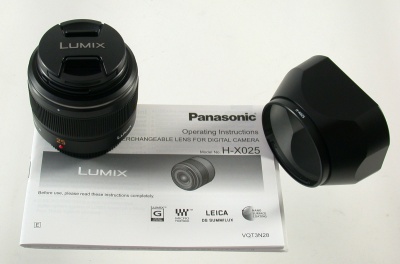
LEICA DG SUMMILUX 1:1,4/25 ASPH. - mit freundlicher Genehmigung von team-foto.com
LEICA DG SUMMILUX 1:1,4/25 ASPH. - mit freundlicher Genehmigung von team-foto.com
LEICA DG SUMMILUX 1:1,4/25 ASPH. - mit freundlicher Genehmigung von team-foto.com
LEICA DG SUMMILUX 1:1,4/25 ASPH. - mit freundlicher Genehmigung von team-foto.com
LEICA DG SUMMILUX 1:1,4/25 ASPH. - mit freundlicher Genehmigung von team-foto.com
LEICA DG SUMMILUX 1:1,4/25 ASPH. - mit freundlicher Genehmigung von team-foto.com
LEICA DG SUMMILUX 1:1,4/25 ASPH. - mit freundlicher Genehmigung von team-foto.com
LEICA DG SUMMILUX 1:1,4/25 ASPH. - mit freundlicher Genehmigung von team-foto.com
LEICA DG SUMMILUX 1:1,4/25 ASPH. - mit freundlicher Genehmigung von Foto Brell, Frankfurt
MTF-Chart und Linsenschnitt des LEICA DG SUMMILUX 1:1,4/25 ASPH. - mit freundlicher Genehmigung von panasonic.de
LEICA DG SUMMILUX 1:1,4/25 II ASPH.
Beschreibung
Im August 2019 wurde diese Variante vorgestellt, folgende Verbesserungen wurden durchgeführt:
- Spritzwasser- und Staubschutz
- Nano Surface Coating
- kompatibel zum Highspeed-Präzisions-Kontrast-AF-System der aktuellen LUMIX G Kameras mit einem Datenaustausch bis maximal 240 B/s
Hierzu ein Zitat aus "Testbericht: Panasonic Leica DG Summilux 25 mm 1.4 II Asph." in digitalkamera.de:
- "Zwar blieb der optische Aufbau identisch, die kompakte Festbrennweite erhielt aber eine schnellere Kommunikation mit der Kamera für einen verbesserten Autofokus sowie einen Spritzwasser- und Staubschutz."
Panasonic-Code: H-XA025
Galerie
LEICA DG SUMMILUX 1:1,4/25 II ASPH. - mit freundlicher Genehmigung von panasonic.de
LEICA DG SUMMILUX 1:1,4/25 II ASPH. - mit freundlicher Genehmigung von panasonic.de
LEICA DG SUMMILUX 1:1,4/25 II ASPH. - mit freundlicher Genehmigung von panasonic.de
LEICA DG SUMMILUX 1:1,4/25 II ASPH. - mit freundlicher Genehmigung von panasonic.de
MTF-Chart des LEICA DG SUMMILUX 1:1,4/25 II ASPH. - mit freundlicher Genehmigung von panasonic.de
Linsenschnitt des LEICA DG SUMMILUX 1:1,4/25 II ASPH. - mit freundlicher Genehmigung von panasonic.de
Tests und Bewertungen
Vergleich zwischen dem Leica D Summilux 25mm F1.4 Asph. (FT) und dem LEICA DG SUMMILUX 1:1,4/25 ASPH. (mFT)
Hier einige Zitate dazu aus dem dslr-forum:
- "Ich hatte beide nacheinander...
Also an FT die ältere Version und jetzt eben die MFT-Variante. Daher geht nur ein Erinnerungsvergleich.
Das FT 25er war sehr gut. Das Vollmetallgehäuse ist solide, kann im Winter aber naturgemäß auch unangenehm kalt werden. Das Objektiv hat eine leichte, wenig störende Verzeichnung (die an MFT natürlich nicht automatisch korrigiert wird). Es konnte bei bestimmten Lichtsituationen allerdings haarsträubende CAs produzieren, was ich als einzigen echten Fehler ansehe. Am Adapter machte es sich ziemlich gut, selbst an der ollen E-P1 ging es mit AF ganz gut. Es ist aber natürlich eine Wuchtbrumme und mit Adapter extrem kopflastig.
Das mFT ist möglicherweise schwächer an den Rändern. Das würde wohl nur ein direkter Vergleich nachweisen können. Es ist viel kleiner und handlicher als die FT-Variante. Was mich allerdings am meisten wundert: Das MFT erzeugt sofort einen Wow-Effekt, den ich von der FT-Variante so nicht in Erinnerung habe. Die Farben und Kontraste und auch das Bokeh scheinen mir im Erinnerungsvergleich beim neueren Objektiv spürbar schöner. Als einzige "Schwächen" bleiben wohl die uninspirierte Plastikhülle und die nicht überragende (aber immer noch gute) Randschärfe."
Bewertungen von DXOmark
Zur Einschätzung des Objektivs einige vergleichende Wertungen von DXOmark (jeweils an einer Olympus E-M1 OM-D):
| Objektiv | DxOMark Score | Sharpness | Transmission | Distortion | Vignetting | Chr. aberration |
| LEICA DG SUMMILUX 1:1,4/25 ASPH. | 24 | 11 MP | F1.7 | 1.6% | -1.2EV | 14µm |
| Olympus M.ZUIKO DIGITAL 25mm F1.2 PRO | 23 | 10 MP | F1,6 | 0.2% | -1.2EV | 15µm |
| Olympus M.ZUIKO DIGITAL 25mm F1.8 | ? | ? MP | F?.? | ?.?% | -?.?EV | ?µm |
| Olympus M.ZUIKO DIGITAL ED 30mm F3.5 MACRO | ? | ? MP | F?.? | ?.?% | -?.?EV | ?µm |
| Panasonic LUMIX G 25mm F1.7 ASPH. | 20 | 7 MP | F2.0 | 1.2% | -1.4EV | 19µm |
| Panasonic LUMIX G Macro 30mm F2,8 II ASPH. O.I.S | 19 | 9 MP | F3.1 | 0.4% | -1.2EV | 6µm |
| Sigma 30mm F1.4 DC DN Contemporary | 24 | 10 MP | F1.7 | 0.8% | -0.9EV | 5µm |
| Sigma 30mm F2.8 EX DN | 17 | 8 MP | F3.1 | 0.2% | -0.8EV | 22µm |
| Sigma 30mm F2,8 DN [A] | 18 | 8 MP | F3.1 | 0.3% | -0.7EV | 21µm |
Weblinks
- Produktvorstellung von Panasonic Deutschland
- Test bei traumflieger.de
- Datenblatt bei digitalkamera.de
- "Nokton 25/0.95 vs. Panasonic Lumix DG 25/1.4" von Peter Lück
- Review bei benjamin-jehne.blogspot.de
- "Testbericht: Panasonic Leica DG Summilux 25 mm 1.4 II Asph." in digitalkamera.de
- Labortest des "Panasonic Lumix 25mm 1.4 Mk II" bei digitalkamera.de (kostenpflichtig)
- Vergleichstest mit dem M.ZUIKO DIGITAL 25mm F1.8 bei robinwong.blogspot.it (englisch)
- Test in photozone.de (englisch)
- Review bei lenstip.com (englisch)
- "Comparing two Panasonic standard primes – Lumix 25mm f/1.7 vs. Leica 25mm f/1.4" in mirrorlessons.com (englisch)
- Review bei kurtmunger.com (englisch)
- Vergleich M.ZUIKO DIGITAL ED 25mm 1:1.2 PRO <-> M.ZUIKO DIGITAL 25mm F1.8 <-> LEICA DG SUMMILUX 1:1,4/25 ASPH. <-> Voigtländer Nokton 25 mm F0.95 bei lensrentals.com (englisch)
- "14 MFT-Objektive getestet" in markuswaeger.com
- "MFT Must Have... Sigma 30mm 1.4 vs. Panasonic Leica 25mm 1.4" von Krolop&Gerst (Video - sehenswert)
- "Panasonic Lumix 25mm 1.4 Mk II - Neuauflage des Klassikers" von Krolop&Gerst (Video)
